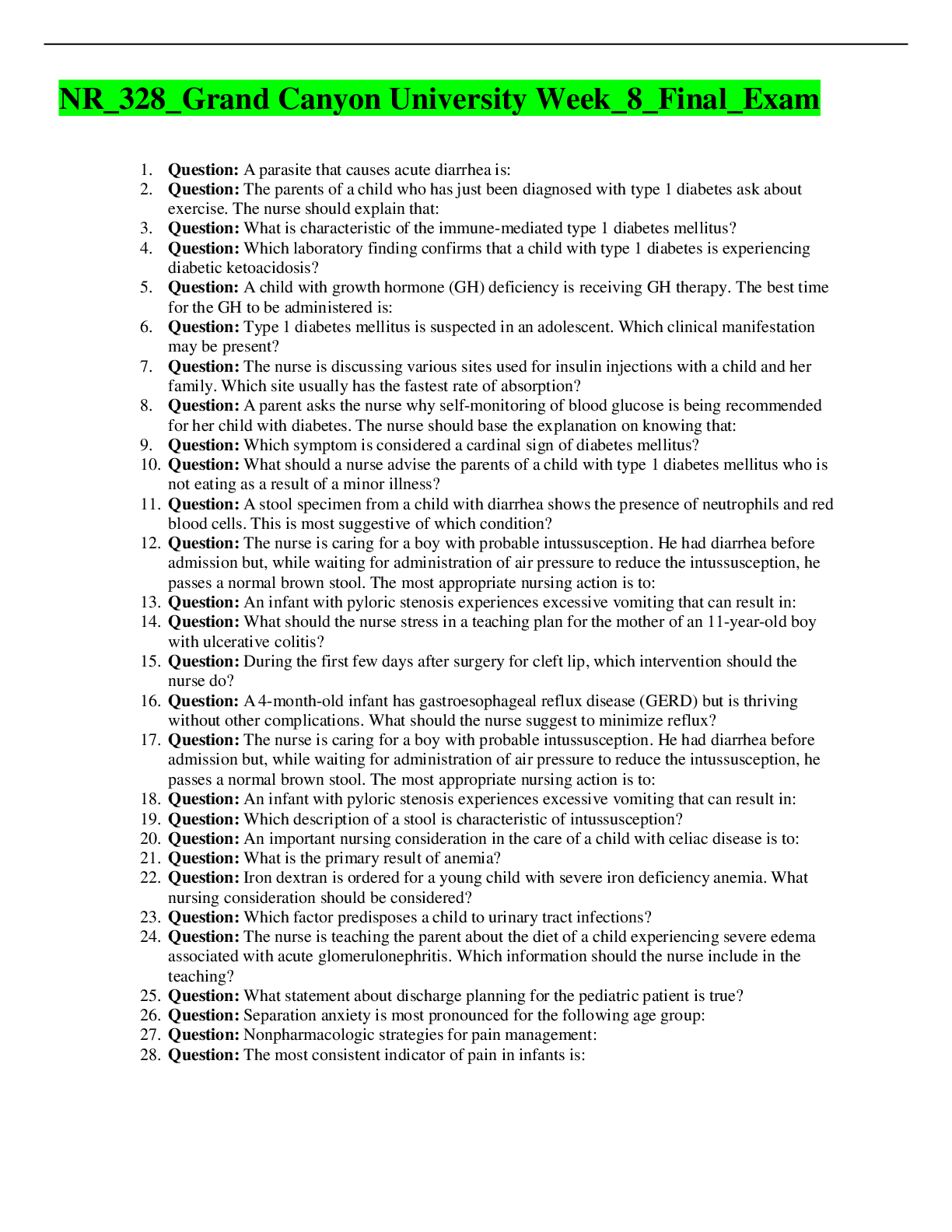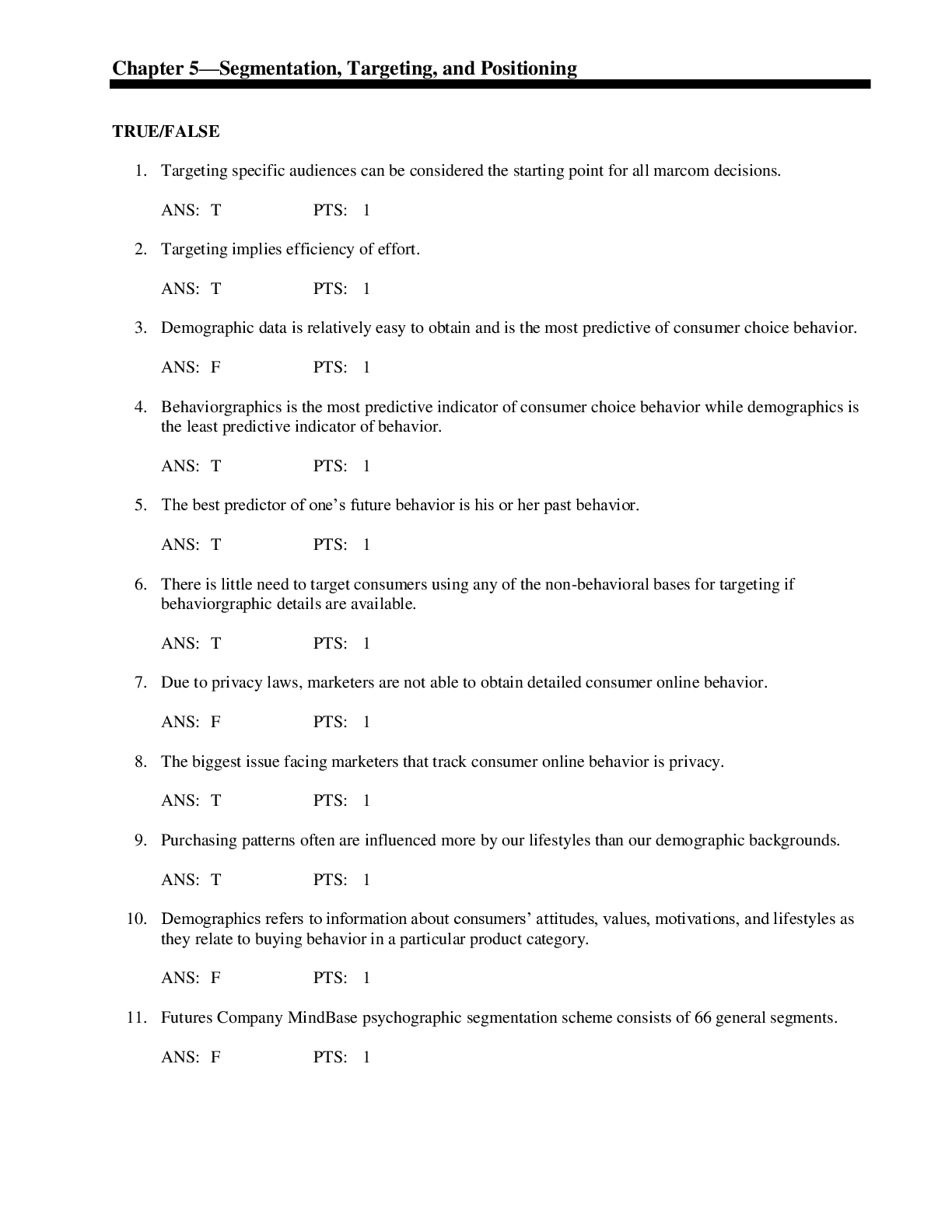Pathophysiology > QUESTIONS & ANSWERS > PATHOPHYSIOLOGY_PATHO 2410 Protection and or Adaptation (CP1) Test Bank Exam Tested Questions and An (All)
PATHOPHYSIOLOGY_PATHO 2410 Protection and or Adaptation (CP1) Test Bank Exam Tested Questions and Answers (Revised 2021 Exam Study Guide)
Document Content and Description Below
PATHOPHYSIOLOGY PATHO 2410 Protection/Adaptation (CP #1) Test Bank Exam Tested Questions and Answers Chapter 1 1. Which of the following would be the most likely cause of an iatrogenic disease? a... . An inherited disorder b. A combination of specific etiological factors c. An unwanted effect of a prescribed drug d. Prolonged exposure to toxic chemicals in the environment 2. The manifestations of a disease are best defined as the: a. Subjective feelings of discomfort during a chronic illness. b. Signs and symptoms of a disease. c. Factors that precipitate an acute episode of a chronic illness. d. Early indicators of the prodromal stage of infection. 3. The best definition of the term prognosis is the: a. Precipitating factors causing an acute episode. b. Number of remissions to be expected during the course of a chronic illness. c. Predicted outcome or likelihood of recovery from a specific disease. d. Exacerbations occurring during chronic illness. 4. Which of the following is considered a systemic sign of disease? a. Swelling of the knee b. Fever c. Pain in the neck d. Red rash on the face 5. Etiology is defined as the study of the: a. Causes of a disease b. Course of a disease c. Expected complications of a disease d. Manifestations of a disease 6. A type of cellular adaptation in which there is a decrease in cell size is referred to as: a. Hypertrophy b. Metaplasia c. Anaplasia d. Atrophy 7. A change in a tissue marked by cells that vary in size and shape and show increased mitotic figures would be called: a. Metaplasia b. Atrophy c. Dysplasia d. Hypertrophy 8. A deficit of oxygen in the cells usually due to respiratory or circulatory problems is called: a. Apoptosis b. Ischemia c. Hypertrophy d. Necrosis 9. When a group of cells in the body dies, the change is called: a. Ischemia b. Gangrene c. Hypoxia d. Necrosis 10. Rigorous weight lifting/body building regimens may result in the skeletal muscle cells undergoing: a. Hypertrophy b. Dysplasia c. Atrophy d. Regeneration 11. The term cancer refers to: a. Dysplasia b. Hyperplasia c. Metaplasia d. Malignant neoplasm 12. To which of the following does the term apoptosis refer? a. Increased rate of mitosis by certain cells b. Ischemic damage to cells c. Liquefaction of necrotic tissue d. Preprogrammed cell self-destruction 13. Which of the following statements is TRUE? a. Alteration of DNA does not change cell function. b. Damaged cells may be able to repair themselves. c. All types of cells die at the same rate. d. Mild ischemia causes immediate cell death. 14. Caseation necrosis refers to an area where: a. Cell proteins have been denatured. b. Cell are liquefied by enzymes. c. Dead cells form a thick cheesy substance. d. Bacterial invasion has occurred. 15. Routine application of sun block to skin would be an example of: a. An iatrogenic cause of cancer b. A preventative measure c. A precipitating factor d. A predisposing condition 16. A circumstance that causes a sudden acute episode of a chronic disease to occur is termed: a. Latent stage b. Predisposing factor c. Incidence d. Precipitating factor 17. The term homeostasis refers to: a. The causative factors in a particular disease. b. Maintenance of a stable internal environment. c. A condition that triggers an acute episode. d. A collection of signs and symptoms. 18. Which term is used to describe a new and secondary or additional problem that arises after the original disease has been established? a. Symptoms b. Occurrence c. Manifestations d. Complication 19. Pathophysiology involves the study of: a. The structure of the human body. b. The functions of various organs in the body. c. Functional or structural changes resulting from disease processes. d. Various cell structures and related functions. 20. Which of the following is the best definition of epidemiology? a. The science of tracking the occurrence and distribution of diseases b. The relative number of deaths resulting from a particular disease c. Identification of a specific disease through evaluation of signs and symptoms d. The global search for emerging diseases [Show More]
Last updated: 2 years ago
Preview 1 out of 26 pages
 Test Bank Exam Tested Questions and Answers (Revised 2021 Exam Study Guide).png)
Buy this document to get the full access instantly
Instant Download Access after purchase
Buy NowInstant download
We Accept:

Reviews( 0 )
$14.00
Can't find what you want? Try our AI powered Search
Document information
Connected school, study & course
About the document
Uploaded On
Jun 04, 2021
Number of pages
26
Written in
Additional information
This document has been written for:
Uploaded
Jun 04, 2021
Downloads
0
Views
87


 Questions and Answers (latest Update), All Correct, Download to Score A.png)






, (A Grade), Questions and Answers, All Correct Study Guide, Download to Score A.png)
, Questions and Answers, All Correct Study Guide, Download to Score A.png)
, Latest Questions and Answers with Explanations, All Correct Study Guide, Download to Score A.png)













